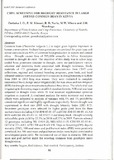| dc.description.abstract | Common bean (Phaseolus vulgaris L.) is major grain legume improtant in
human consumption. Andean bean genotypes are prefered for grain type and
colour and constitute 60% of common bean production in eastern and central
africa. Drought causes loss of 395,000t annually in Africa. Genotypes
resistant to drought do exist. The objective of this study was to select large
seeded bean genotypes resistant to drought, carry out participatory variety
selection and determine traits associated with drought resistance. Study
materials of 175 genotypes of diverse characteristics from CIAT core
collections, regional and national breeding programs, gene bank, and local
released varieties were evaluated for five seasons in drought nursery at Kabete
from 2008 to 2010 long rain season. They were evaluated in complete
randomized block design under irrigated (IR) for non stress and non-irrigated
(NIR) for drought stress treatments replicated three times. The whole trial was
irrigated up to flowering stage to establish stand uniformity. NIR trial was later
subjected to drought stress while IR trial received supplemental sprinkler
irrigation as required. A combined analysis for water treatment and season
effects were subjected to analysis of variance with 5% and 1% probability
considered significant and highly significant respectively. Severe drought was
experienced in short rain 2008 with drought Intensity Index (DII) 0.75.
Seventeen genotypes were selected for higher grain yield from the three
market classes including CIM-RM-02-01-07 and CIM-RM-02-04-03, ECAB
0031 and CIM-RK-03-03-14, NS 15457-3 and Sharp black. Drought severely
reduced the grain yield by 22.3% in 2010 and 33% in 2009. Farmers selected
12 genotypes including NS 15454-28, MR14215-5-1P, CIM-RK-03-03-01,
GCI-Ca1271-AR2, AFRI 708 and KAB 150. Days to flowering (DF), days to
maturity (DM), 100 seed mass and pod harvest index (PHI) were positively
correlated, but 100 seed mass and pod harvest index were highly correlated to
non-irrigated grain yield. We recommend use of days to maturity, 100 seed
mass and pod harvest index for selecting common bean genotypes under
drought stress. | en_US |

